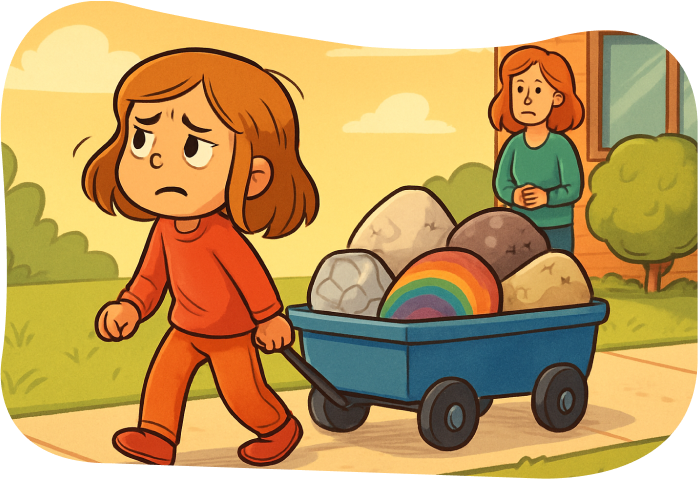
Featuring The Blue Wagon by Karen R. Sullivan
At six years old, Heather sets off with an empty blue wagon and a head full of curiosity. Her goal? Find treasures. By the end of her walk, her wagon is heavy. But the story in The Blue Wagon, the debut children’s book by Karen R. Sullivan, reveals something deeper: kids aren’t just collecting rocks—they’re carrying weight.
Not literal weight. Emotional weight.
From the outside, Heather’s wagon is filled with beautiful things—crystal-speckled stones, smooth white marble, a rainbow-painted rock. But as she grows tired from pulling them, the story shifts. This isn’t just about shiny discoveries. It’s about what we pick up along the way. The burdens we don’t realize we’re carrying until they start to pull on us.
This metaphor sits at the emotional heart of Sullivan’s book. Each rock is symbolic of memories, expectations, unnoticed gifts, and even abandonment. The wagon becomes a moving illustration of how emotional burdens accumulate in childhood, sometimes without words, often without adults noticing.
Karen R. Sullivan’s book is deceptively simple, written with the cadence of a bedtime story, but underneath it lives a message that hits hard: children carry emotional weight, too. They may not have bills to pay or meetings to attend, but they shoulder worries, loneliness, confusion, and sometimes even a parent’s stress—all tucked behind small smiles and quiet behavior.
The beauty of The Blue Wagon is in how softly it handles this truth. There’s no melodrama. No lecture. Just a child on a sidewalk, pulling her treasures, discovering what they mean.
Let’s talk about the wagon.
It’s a stunning metaphor, not just for children, but for adults as well. Heather’s realization—that the way back home is harder than the way out—mirrors how life feels when we accumulate too much emotional baggage. It’s a message that will hit home for parents, educators, and anyone who remembers being a child with feelings too big to name.
Author Karen R. Sullivan explains:
“I wanted the story to show that children are not just carefree and playful. They feel deeply. And sometimes they’re carrying more than we know.”
She knows this from experience, not just as a storyteller to her nephews, but as someone who has faced her own journey through healing and self-doubt. The Blue Wagon began as a simple story. But like many authors, Sullivan struggled with uncertainty once the writing was done.
“I never thought I’d write a children’s book,” she admits. “I always imagined writing for the inner child. But this book surprised me. It turned out to be both.”
That duality is what makes the book so effective. Children will be enchanted by Heather’s treasure hunt. Adults will see the emotional layers woven through the narrative.
Let’s not forget the role of Mr. Wiggledimp—the gentle, slightly whimsical neighbor who gifts Heather his treasured rainbow rock. His children don’t want it anymore, so he gives it to her. This seemingly small gesture speaks volumes. It’s about the connection between generations, the loneliness of growing older, and the idea that value is personal, not universal.
That line could be a thesis statement for the entire book. It invites both child and adult readers to rethink how they define worth, whether it’s a rock, a feeling, or a relationship.
Later, when Heather’s mother finally takes the time to look at her treasures, she sees them not as random rocks, but as symbols of something heavier. Heather explains how tired she felt. Her mother listens—and responds with something rare in children’s books: honesty.
“Sometimes grown-ups pull thoughts instead of wagons,” she says. “And those thoughts get heavy just like your rocks.”
In that moment, mother and daughter understand each other. Not just in words, but in weight. It’s a powerful exchange, offering a rare and respectful view of a child’s capacity to understand emotional complexity.
This kind of storytelling isn’t common in picture books. It doesn’t preach, it doesn’t condescend, and it doesn’t try to tie things up in a neat little bow. Instead, it gives space for reflection, for interpretation, for conversation.
And that’s what makes The Blue Wagon stand out in a crowded genre.
It’s not just a picture book about healing and hope. It’s a tool for talking about the unseen weights we carry. It’s an illustrated book on empathy. A story about kindness and the emotional burdens that often go unnoticed.
Whether you’re a parent who wants to connect with your child on a deeper level, an educator looking for a gentle way to introduce social-emotional learning, or an adult still unpacking your own childhood, The Blue Wagon delivers.
Final Thought:
We all carry wagons, even if they’re invisible. What’s inside might look like rocks to others, but to us, they’re pieces of our story. What Karen R. Sullivan reminds us through Heather’s journey is simple but profound:
If we take the time to look inside each other’s wagons, we might just understand what’s really weighing us down—and how much lighter things feel when someone helps us pull.
Quick Links
Useful Links
Copyright © 2025 Karen Sullivan. All Rights Reserved.